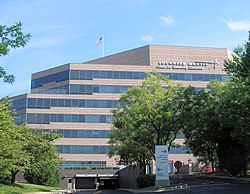This article has multiple issues. Please help improve it or discuss these issues on the talk page . (Learn how and when to remove these messages)
|
| | |
| Company type | Division |
|---|---|
| Industry | |
| Predecessors | Lockheed Corporation Martin Marietta |
| Founded | 1995 |
| Headquarters | |
Key people | James D. Taiclet (chairman, president & CEO) Bruce L. Tanner (executive vice president and CFO) |
| Revenue | $17.769 billion (2016 [2] ) |
| $1.877 billion (2016 [2] ) | |
Number of employees | |
| Website | www |
Lockheed Martin Aeronautics Company is a major unit of Lockheed Martin with headquarters at Air Force Plant 4 in Fort Worth, Texas, with additional facilities are located Marietta, Georgia and Palmdale, California.
Contents
Palmdale is home to the Advanced Development Programs (ADP), informally known as the "Skunk Works". Various subassemblies are produced at locations in Florida, Mississippi, Pennsylvania, and West Virginia.
The company draws upon the history of the former Lockheed and Martin Marietta corporations. While the formation of Lockheed Martin in 1995 was a merger of equals, by far the greatest contribution to Lockheed Martin Aeronautics was the product portfolio of Lockheed. This included the C-5, C-130, and C-141 transports as well as the F-2, F-16 (purchased from General Dynamics), F-117, F-22, and F-35 Lightning II.
The most important project by far to Lockheed Martin Aeronautics is the F-35 Lightning II (JSF). Worth a potential $200bn the initial order book is approximately 3,000 excluding almost guaranteed export orders. Lockheed also supports its F-22 air dominance fighter in USAF service.








